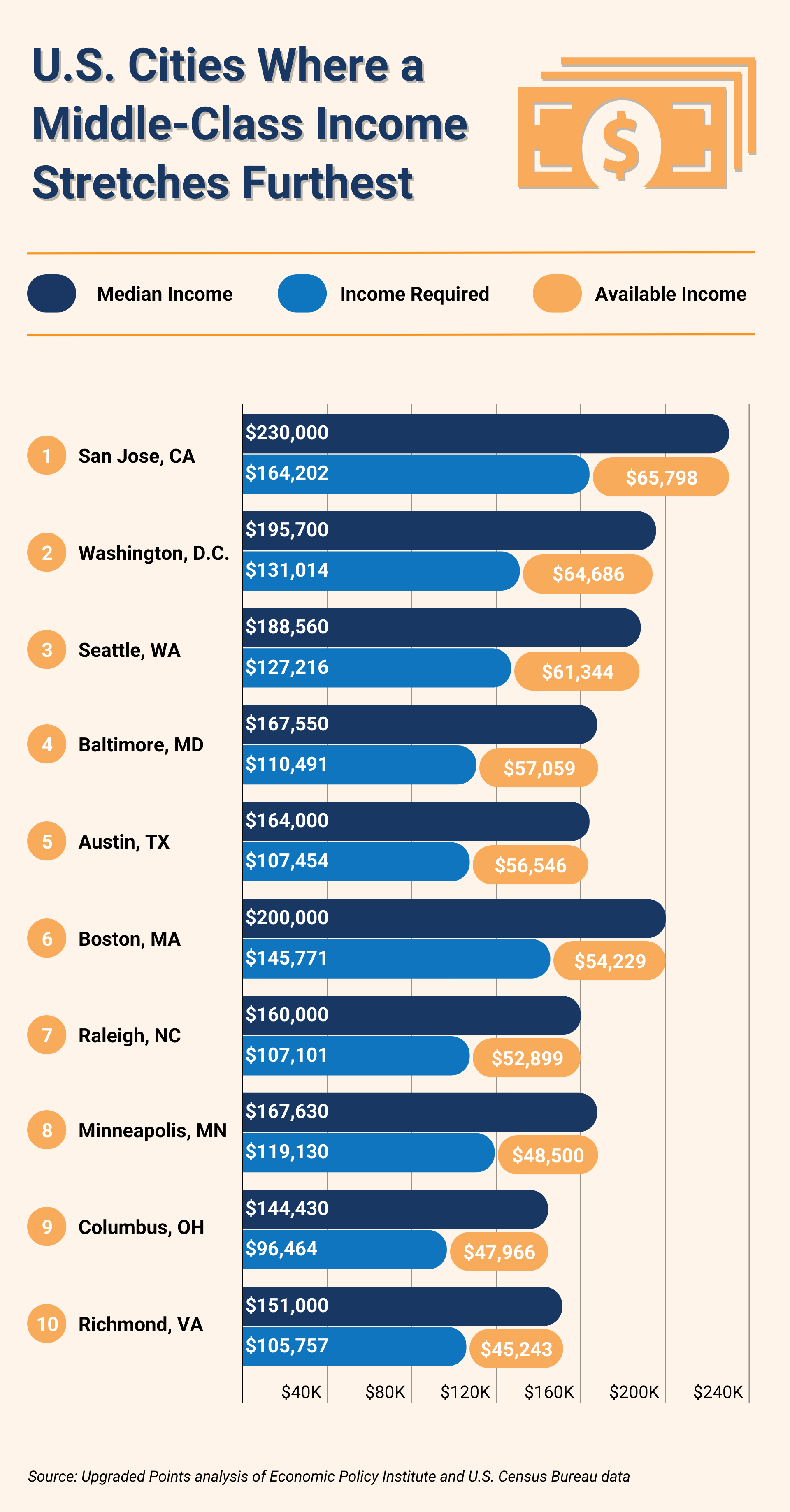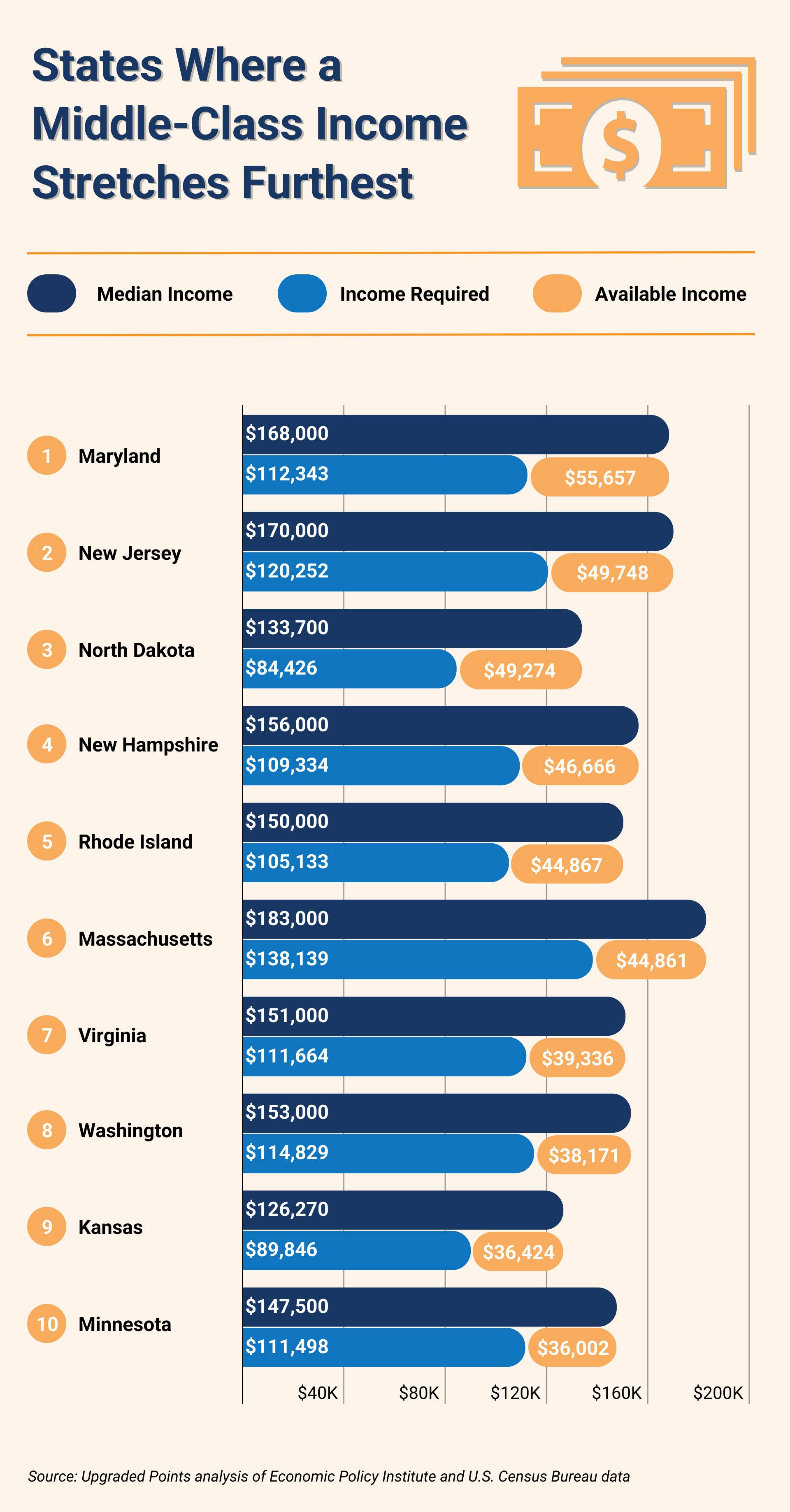As economic pressures mount, middle-class families across the U.S. are finding it increasingly difficult to cover essential living expenses while maintaining a comfortable lifestyle. Rising costs for housing, healthcare, childcare, and transportation have placed additional strain on household budgets, leaving many unable to save or spend on discretionary items. While these financial pressures affect families nationwide, the degree to which a middle-class income stretches varies significantly depending on location.
This report examines where in the United States middle-class families can achieve the most financial security. By comparing the income required to cover essential expenses to the median family income in each location, the findings highlight areas where households have the most financial breathing room. To control for variations in family size and composition across locations, all of the statistics used are for 2-adult households with 2 children. The results shed light on how regional differences in cost of living and wages impact the ability of middle-class families to invest in more than just getting by — whether that means saving for retirement, spending on recreation and entertainment, or taking a vacation.
Key Takeaways
- National Overview:Â Across the U.S., the average middle-class family has $21,939 in available income after covering essential expenses. Housing, childcare, and healthcare account for the largest shares of the $108,061 in income required to cover basic necessities.
- Top and Bottom Cities:Â Cities like San Jose; Washington, D.C.; and Seattle top the list of large metros due to exceptionally high median family incomes that outpace their elevated costs of living. Conversely, Los Angeles ranks near the bottom due to a combination of high costs and lower-than-expected incomes for middle-class families, leaving little leftover income after necessities.
- Counterintuitive Findings:Â Some high-cost cities rank well because their median incomes are proportionally higher, allowing families to retain more after necessities. Meanwhile, some lower-cost cities struggle due to incomes that fail to keep pace with even modest expenses, highlighting disparities across different economic regions.
- Take-Home Income Caveat:Â While the analysis focuses on available income after necessities, this figure does not account for additional taxes owed on leftover income. Families may choose to invest some or all of this income in pre-tax savings plans, such as retirement accounts, which makes estimating tax amounts not feasible.
Top Cities for Middle-Class Earners

While affordability might seem synonymous with lower living costs, the cities where middle-class families enjoy the most financial breathing room often defy expectations. Some of the most expensive areas in the U.S., such as San Jose; Washington, D.C.; and Seattle, top the list of cities where families have the most available income after covering necessities. The key to this counterintuitive trend lies in the high median family incomes in these regions, which outpace their elevated living costs. These cities, which are often hubs of technology, government, and research, enable middle-class households to maintain a comfortable lifestyle despite the higher price of essentials.
In San Jose, for example, the median family income for 2-adult households with 2 children is an impressive $230,000 — far exceeding the national median of $130,000. Although the cost of necessities is higher, with housing alone accounting for $34,993 annually, families still retain $65,798 after covering essential expenses. Similarly, Washington, D.C., and Seattle, both known for thriving economies and high-paying industries, provide middle-class families with $64,686 and $61,344, respectively, in available income after necessities.
Many of the top-performing cities on this list share common characteristics as centers for innovation, education, and professional opportunities. Places like Austin and Boston, which rank fifth and sixth, respectively, exemplify how strong local economies with high-paying jobs can offset higher living costs. Despite Boston's significant housing costs — averaging $28,819 annually — its high median income of $200,000 enables families to retain over $54,000 after covering necessities.
At the other end of the spectrum, cities in California, Nevada, and Florida highlight how stagnant incomes or disproportionately high costs can strain middle-class budgets. Los Angeles, for instance, is infamous for its high housing costs, averaging $27,581 annually. With a median family income of $136,800, families in L.A. have just $2,626 left after covering their essential expenses. Meanwhile, Fresno, despite having a cost of living close to the national average, ranks near the bottom due to a lower median income of $109,600, leaving families with only $8,089 in available income. Similarly, Las Vegas and Miami suffer from below-average incomes combined with rising housing and childcare costs, further limiting families' financial flexibility.
These findings highlight the complex interplay between wages and living costs. While expensive cities often provide middle-class earners with higher disposable income, families in more moderately priced locations can face tighter financial constraints if wages fail to keep pace with cost of living.
Top States for Middle-Class Earners

The states where middle-class families fare best present a diverse mix of geographies, economies, and living costs. While many of the top-ranking states are in the Northeast, known for their higher wages and strong economies, the list also includes states from the Midwest and Great Plains, where a lower cost of living allows incomes to stretch further. Conversely, states where middle-class families struggle the most are often characterized by stagnant wages, high costs of living, or a combination of both, with several Western and Southern states ranking near the bottom.
Maryland leads the nation, offering middle-class families an average of $55,657 in available income after necessities. Despite moderately high housing and childcare costs, the state’s high median family income of $168,000, driven by its proximity to the economic hub of Washington, D.C., ensures families retain substantial financial flexibility. Other top-performing states, like New Jersey and Massachusetts, follow a similar pattern, benefiting from robust local economies centered around finance, technology, and healthcare.
Interestingly, North Dakota, ranked third, highlights how smaller, more rural states can provide exceptional opportunities for middle-class families. With a low median income requirement to cover necessities ($84,426), North Dakota allows families to retain $49,274 after essentials — thanks to relatively low housing, food, and childcare costs.
At the bottom of the rankings, there’s a striking mix of states with both extremely high and relatively low living costs. On the high-cost side, California and New York illustrate how even substantial incomes can be overwhelmed by exorbitant expenses. In California, a median family income of $142,000 is offset by housing costs averaging $25,840 annually, along with significant expenses for childcare and taxes. Similarly, New York’s median income of $144,000 is eroded by steep housing costs and the highest childcare expenses and taxes in the country, leaving families with just $7,141 in available income after necessities.
On the other hand, lower-cost states like West Virginia, Wyoming, and New Mexico rank poorly due to incomes that lag behind even modest living expenses. In West Virginia, for example, the median family income of $101,000 is not enough to meet the $102,474 required to cover necessities, making it the only state where families face a deficit. Similarly, Wyoming residents face below-average incomes paired with above-average costs in certain categories that outpace what middle-class families can afford.
This juxtaposition highlights the challenges middle-class families face at both ends of the cost spectrum. In high-cost states, strong economies and higher incomes aren’t always enough to make up for rising prices, while in lower-cost states, incomes often fail to provide the financial stability families need to get ahead.
This analysis was performed by , a company that provides advice on credit cards rewards programs and other financial products, using data from the Economic Policy Institute and the U.S. Census Bureau. Researchers calculated the available income after necessities for each location. This metric represents the difference between the median family income and the income required to cover essential expenses.
Here is a summary of the data for New Mexico:
- Available income after necessities: $5,469
- Median family income: $100,000
- Income required to cover necessities: $94,531
- Housing costs:Ěý$12,306
- Food costs: $11,705
- Childcare costs: $16,839
- Transportation costs: $16,697
- Healthcare costs: $17,572
- Other necessities costs: $8,503
- Income taxes: $10,909
For reference, here are the statistics for the entire United States:
- Available income after necessities: $21,939
- Median family income: $130,000
- Income required to cover necessities: $108,061
- Housing costs: $17,221
- Food costs: $12,456
- Childcare costs: $19,896
- Transportation costs: $17,587
- Healthcare costs: $16,254
- Other necessities costs: $10,507
- Income taxes: $14,137
For more information, a detailed methodology, and complete results, see  on Upgraded Points.

